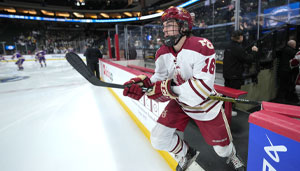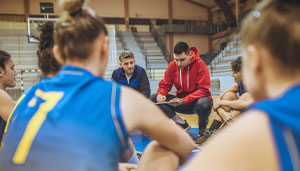The Baseball Rule: Liability to Spectators for Foul Ball Injuries
By Lee Green, J.D. on November 10, 2021 hst PrintIn Re Casey & the Mudville Baseball Club
If Ernest Thayer’s poem Casey at the Bat, first published in the San Francisco Examiner on June 3, 1888, and popularized by thousands of performances in the late 19th and early 20th centuries by vaudevillian DeWolf Hopper, along with hundreds of recitations in the 21st century by National Baseball Hall of Fame staffer Tim Wiles, was published today, the famous composition would likely end differently because of a modern sports law issue.
The original version, featuring the Mudville Nine down by two runs in the bottom of the final inning, with runners on second and third, and star player Casey in the batter’s box facing an 0-2 count, concluded its 13 stanzas with the following two:
The sneer is gone from Casey’s lip, his teeth are clenched in hate; he pounds with cruel violence his bat upon the plate. And now the pitcher holds the ball, and now he lets it go, and now the air is shattered by the force of Casey’s blow.
Oh, somewhere in this favored land the sun is shining bright; the band is playing somewhere, and somewhere hearts are light, and somewhere men are laughing, and somewhere children shout; but there is no joy in Mudville – mighty Casey has struck out.
The end of the modern verse, however, because of a frequently recurring event across all levels of baseball and a common type of lawsuit against professional teams, colleges and high schools, would likely be worded as follows:
…but there is no joy in Mudville – as mighty Casey hammers the ball, and in a millisecond into the stands, the tiny orb takes flight, with the fan against whose head it collides, seeing only a flash of white.
After surgery, pain, and medical expense – a result staggeringly cruel, the club still refused to protect its fans, playing the part of organizational fool, believing it could always hide behind the legal doctrine’s shield, known to fallen fans of Mudville, simply as the “baseball rule.”
The Baseball Rule
The “Baseball Rule” is a longstanding legal doctrine that the operators of baseball facilities have a limited duty to protect fans from the risk of being hit by a foul ball and that spectators assume that risk because it is an inherent danger associated with attending a ballgame.
The judicial principle first emerged on a widespread scale from a 1942 Missouri Supreme Court decision, Hudson v. Kansas City Baseball Club, that relied on previous lower court decisions during the first four decades of the 20th century which concluded that because of the high frequency of foul balls flying into the stands and injuring fans, the danger was common knowledge to most attendees at games and teams had the legal obligation only to provide 1) a reasonable number of protected seats and 2) reasonable warnings of foul ball risks to spectators, responsibilities that were fulfilled by erecting a backstop directly behind home plate and communicating oral or written cautions regarding the danger, a mandate courts considered to be satisfied by ballpark signage and language included on waivers printed (albeit in microscopic fonts) on the back of tickets.
During the last half of the 20th century, there was widespread adoption by state courts across the country of the baseball rule and baseball facility operators were consistently shielded from liability for spectator injuries from foul balls, with a dubious argument underpinning most of those rulings – the assertion that the fan in question could have avoided injury if only he or she had been better focused on the game and ducked out of the path of the foul ball as it was flying into the stands.
The landmark high school court case, Akins v. Glen Falls City School District, a 1981 decision by the highest court in New York, applied the baseball rule to reverse a $100,000 jury award to a woman who lost an eye when hit in the face by a hard-hit foul ball while watching from a vantage point along the third-base line as her son played in a high school game. The court held that the baseball rule applied to scholastic contests and in its majority opinion implied that the injured fan was responsible for her own injury because she didn’t dive out of the way as the foul ball was flying in her direction.
In recent years, however, the scope of the problem and the near-impossibility of avoiding a projectile often moving at 100+ miles per hour have resulted in a reconsideration by courts of the assumption of risk argument upon which the baseball rule is based. In 2012, the ESPN show Sport Science aired a segment illustrating that fans sitting anywhere from behind the dugout to the elbow (where the wall angles inward toward the field), even when focused on the game, had an average of .8 of one second to take evasive action from a line-drive foul ball. A 2014 Bloomberg News report revealed that since the turn of the millennium, an average of 1,750 spectators per year were injured by foul balls at MLB games (out of a collective total of 400,000+ foul balls per MLB season). A 2019 investigation by NBC Sports identified 808 serious foul ball injuries (requiring hospitalization) over the previous eight seasons, an average of 27 per MLB stadium.
And that data did not include foul ball injuries in 200+ minor league parks, 2000+ college facilities, and 16,000+ high school baseball stadiums (the 2018-19 NFHS participation survey reported 16,170 schools with baseball programs, many presumably with multiple baseball fields to accommodate varsity, junior varsity, sophomore and freshman teams). Extrapolating the MLB numbers for 30 ballparks to the minor league, college – and high school levels – even with an adjustment for fewer games played and fewer fans in attendance – would yield a likelihood of thousands of foul ball injuries each year, a supposition supported by the high volume of litigation by injured spectators against facility operators, including school districts.
Reconsideration of the need for additional protective screening and warnings, along with challenges to the legal validity of the baseball rule, have accelerated over the course of the last decade with increasing media coverage of many of the most severe foul ball injuries.
In 2010, a six-year-old girl suffered a shattered skull when hit with a line drive behind the third base dugout at Turner Field, the then home of the Atlanta Braves, a case eventually settled with undisclosed terms when it became clear a state court would not apply the baseball rule.
In 2011, a player for Davenport Assumption High School in Iowa sustained a fractured skull when hit by a foul ball in his team’s dugout, resulting in stroke-like brain injuries and eventually leading to a $1.05 million jury award by a court that disregarded the baseball rule.
In 2015, a woman suffered life-threatening injuries when struck by a hard-hit foul, including permanent brain damage, while seated beyond the dugout along the third base line during a Red Sox game at Fenway Park, a case also settled when a court refused to grant summary judgment using the baseball rule.
In 2017, a toddler being held in her father’s arms was struck in the face at Yankee Stadium by a foul estimated to have been moving at 105 mph and which hit her half-a-second after it left the bat, resulting in a lawsuit still working its way through the judicial process.
In 2019, a two-year-old girl suffered a fractured skull, resulting in brain damage and recurrent seizures, when hit by a line-drive foul during an Astros game at Minute Maid Park, a case settled in the summer of 2021 for an undisclosed monetary sum when a court declined to apply the baseball rule to shield the team from liability.
Numerous cases have also been decided in the last decade – many of which included facts more likely to apply to high school facilities than MLB ballparks – in which courts have declined to apply the baseball rule because some form of distraction made it especially difficult for spectators to focus on the game and avoid foul ball dangers. In Rountree v. Boise Baseball, a 2013 Idaho Supreme Court decision, a fan lost an eye when hit by a foul while standing in a club-like concession area adjacent to the field down the third base line. In a 2010 decision, Edward C. v. Albuquerque Isotopes, the New Mexico Supreme declined to apply the baseball rule when a child was severely injured when hit by a ball in a picnic area adjacent to the field. In 2007, in Harting v. Dayton Dragons, an Ohio Court of Appeals decision, the court declined to apply the baseball rule when a fan was struck by a line drive while distracted by the team’s mascot. Other courts have declined to apply the shield when fans were injured while watching pre-game contests of “pepper” (multiple balls being batted simultaneously directly in front of seating areas), when spectators were on concourses or walking paths directly adjacent to fields, and when fans were sitting or standing in unprotected areas along the baselines (typically at high school or youth games).
Most recently, in a 2020 ruling, S.J. v. U.S.A. Baseball Federation, the California Court of Appeals declined to apply the baseball rule to grant U.S.A. Baseball a summary judgment insulating the organization from liability for a foul ball injury that cost a 12-year-old girl her right eye, with the court stating in its written opinion, “to be sure, foul balls are part of baseball. But as the entity responsible for operating [the baseball stadium], USA Baseball had a duty not only to use due care not to increase the risks to spectators inherent in the game, but also to take reasonable measures that would increase safety and minimize those risks.” A full trial in the case is slated for late fall of 2021.
At the league’s Winter Meetings in December 2015, MLB Commissioner Rob Manfred issued a recommendation that all ballparks should extend protective netting to the far end of the dugouts. After only a handful of teams complied and serious foul ball injuries continued to occur, Manfred issued an edict at the 2019 Winter Meetings that all MLB teams were instructed to extend their protective netting before the 2020 season. According to an investigation by Sports Illustrated published in 2021, that directive resulted in six teams constructing foul-pole-to-foul-pole screening, five others with netting beyond the elbows but not all the way to the foul poles, and 19 with protection extending to the elbows.
Recommendations
The following are suggestions for preventative measures that should be implemented in high school ballparks:
- Increase the reach of protective screening to whatever extent is financially feasible, especially in the area behind home plate and along the baselines where foul ball and thrown ball dangers are the greatest.
- At ball fields where spectators bring their own seating (lawn chairs or blankets for ground seating), limit seating to areas behind backstops or screening or to areas out of the “line of fire” of batted or thrown balls.
- Provide signage warning spectators to exercise vigilance against being hit by batted or thrown balls by focusing on the field of play both during pre-game warm-ups and the game itself. The warnings should also instruct parents to safeguard the welfare of young children accompanying them to the game.
- Place warning signage at entrance gates into the ballpark.
- Place warning signage on or adjacent to bleachers not protected by screening.
- Place warning signage on or adjacent to scoreboards or in other locations visible to the entire crowd.
- Where public-address systems are in use, make frequent P.A. announcements before and during games warning spectators about the risks of batted or thrown balls entering the stands.
- Where game programs or roster sheets are distributed to fans, include a warning in an easy-to-read font size in a visible location on the publication.
- Employ additional measures – screening or warning signs – in areas within the foreseeable reach of batted or thrown balls and where the attention of spectators is likely to be diverted from the field of play such as concession stands, restrooms, water fountains, picnic areas, and other multi-purpose use areas where fans might congregate.
- Keep in mind that such preventative measures should be taken both in baseball facilities and softball facilities.
Lee Green, J.D.
Lee Green is an attorney and Professor Emeritus at Baker University in Baldwin City, Kansas, where for 30 years he taught courses in sports law, business law and constitutional law. He is a member of the High School Today Publications Committee. He may be contacted at [email protected].
Most Recent Articles
- nfhs news Final Four Participants Hope to Repeat State Championship Experiences
- nfhs news Former NFHS Assistant Director Susan True Passes Away
- The 2025 HS Track and Field Season is Here!!
- The 2025-26 NFHS Spirit Rules Changes Now Available!
- state news Jamey Harrison Selected Executive Director of Texas University Interscholastic League







